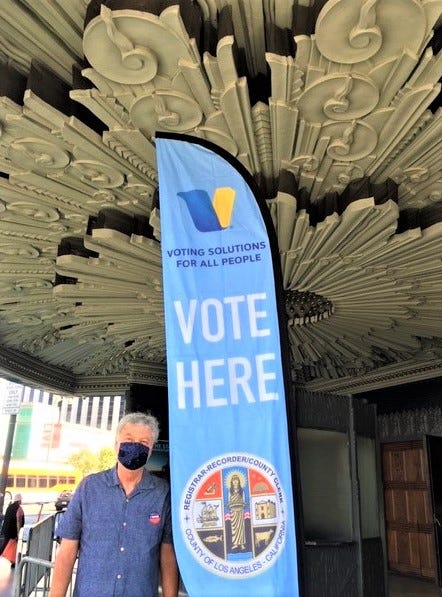
Folks,
That’s me at the Wiltern Theater, kvelling, after I dropped off my mail-in ballot with an oval completely filled in for Joe Biden. If you haven’t done so already, I hope that you can do the same, at the location of your choosing, as I fear for the health of my family and yours, and our freedom to live in a democratic society. And why not? Jews are all about health, life, and the pursuit of justice. There, now that I have gotten that out of the way, we can proceed with this week’s issue, which I hope will help pull you through the next couple of days. See you on the other side.
Shabbat shalom.
Edmon J. Rodman
GUIDE FOR THE JEWPLEXED
Relax with a pre-election Halloween Havdalah
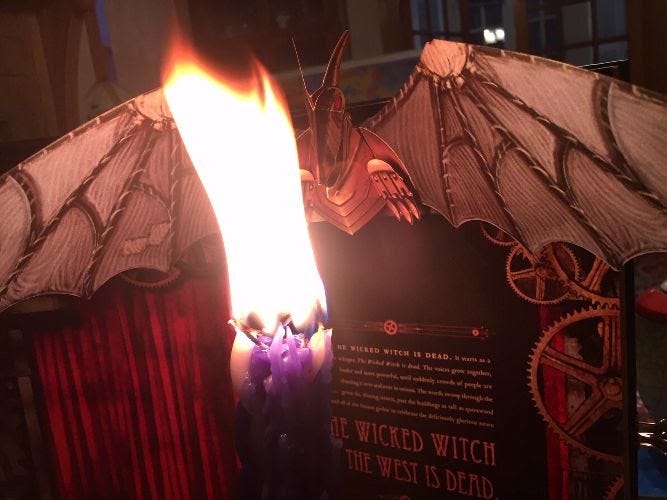
Edmon J. Rodman
Halloween, this year, is our Nightmare Before Election Day, and celebrating Havdalah this Saturday night can help you get through it.
In this time of pre-election high anxiety, when months before October 31, our homes are filled with masks, Shabbat will be ending, Halloween beginning, and you can use this moment to ease the dread of impending tzuris by creating a Halloween Havdalah.
I am suggesting that once you feel the transition from Shabbat to Halloween—from Holy time to the uncertainties of every day—that the sweet recognition of a day of peace will carry you through November 3 and beyond.
Also, with so much social distancing, we need observances like Havdalah to put us spiritually back together.
Requiring a braided multi-wicked candle, a little kosher grape juice or Kiddush wine, and some cloves, nutmeg or cinnamon in a shaker, Havdalah is a wonderful tactile observance whose rewards continue long after the costumes have been put away and the candy gobbled.
For those who imbibe, a shot of liquid tradition afterwards also helps to steady the nerves.
At the heart of Havdalah is the almost tangible distinctiveness of Jewish time.
Rabbi Abraham Joshua Heschel, in his classic book “The Sabbath,” speaks of Shabbat as a spiritual place, a “palace in time,” and if we open the doors and look through the windows from time to time, perhaps we can carry that vision to the other days of the week.
The heart of Havdalah can be found in the phrase “ha’mavdil bain kodesh l’chol,” — “distinguishing between the sacred and the secular.” The name Havdalah comes from the verb “l’havdil,” to separate or distinguish.
Some Jews even say the word l’havdil when they want to make it clear that two things are much different, like saying “Trump and Biden,” that they have no business of even being thought of together.
With Havdalah you are saying l’havdil between Shabbat and Halloween, expressing that there is a difference.
For a text for your service, most prayer books have a page or two for Havdalah. Or find a text HERE.
Don’t have a Havdalah candle? You can also simply hold two candles together with wicks intertwined. Be sure to wrap foil around the candle’s base for a holder.
Wait till you see three stars to begin, and go for the full difference between darkness and light.
Lower the lights. Light the candle and hold it up. Read the first part about deliverance, as we really need it now. In contrast to the fear and shock themes of Halloween and Trump’s dark, near-apocalyptic approach to the election. The first line ends with resolute words for both child and adult: “I am confident and unafraid.”
Say Kiddush, the blessing over the wine. Don’t drink yet.
Kiddush wine or grape juice is a simple drink — not Halloween bubbling punch or a Bloody Mary. It’s sweet and hopefully so will be your Tuesday night.
Next, pick up the spices, “b’samim,” say the blessing. They are a kind of smelling salts to revive your post-Shabbat spirits. (Tuesday night, you might want to keep them nearby.) Shake them, and in a week when we have been holding our collective breaths, breathe them in.
Bless the flame. Two or more wicks burning together show that when our individual flames are combined, the brightness shows betters the difference between light and darkness; between a nation moving from the darkness into the light. To remind yourself of the difference, hold your palms up toward the candle, curve your fingers inward and see the shadows they cast.
Say the final blessings about God creating everything and everyone distinctly different, as well as distinguishing between the sacred and the everyday. Drink some wine.
Put out the candle in the wine. Listen to the sizzle as the candle is quenched; that’s the last four years being extinguished. Better than any sound effect, it is the sound of Shabbat ending and the new week with all its promise of a new beginning.
Sing “Hamavdil,” a feel-good song that connects the blessings of Shabbat to the rest of the week. In an election when we fear that somehow our vote will not be counted, one verse takes on new meaning: “Listen to my voice, cast it not aside
Open up to me the lofty gate.”
Now, wish someone, in whatever way, a “shavuah tov,” a “gutte vokh,” a good week of increasing gladness.
Close the ceremony by singing “Eliyahu Hanavee.”
Better than any costumed character or mask, we have Eliyahu, who legend has it ascended to heaven in a fiery chariot. We leave the door open for him at the seder and invoke his name here at Havdalah, hoping for a time of Shabbat-like messianic peace — a time without COVID-19, and the leadership to get us there.
Uncle David is voting for who?
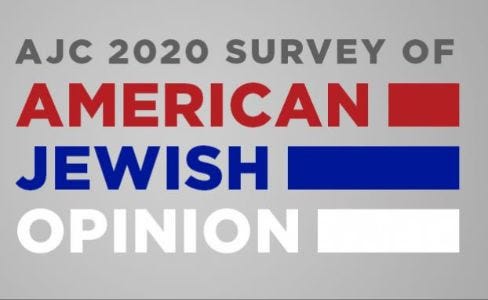
Curious about for whom your Jewish neighbors, friends and relatives are voting for President? Short of asking them (risky) or simply checking out their yard signage (potentially infuriating), the AJC, American Jewish Committee, has partially resolved your dilemma by publishing the results of their 2020 Survey of American Jewish Opinion (Read it HERE.)
Based on a national sample of 1,334 Jews over age 18, the survey found that that 75 percent would choose former Vice President Joe Biden and 22 percent President Donald Trump.
What is the breakdown of Jewish Trumpskis? Trump is preferred by 74 percent of Orthodox, 23 percent of Conservative, 20 percent of Reform, 3 percent of Reconstructionist, and 14 percent of Secular Jews. While the Bideners are 18 percent of Orthodox, 72 percent of Conservative, 78 percent of Reform, 93 percent of Reconstructionist, and 83 percent of secular Jews.
It should come as no surprise that, for a group for whom the preservation of life is preeminent, the most important issue in deciding for whom to vote for prez is the COVID-19 pandemic at 26 percent followed by prioritizing health care 17 percent, the economy 13 percent, race relations 12 percent, crime 6 percent, foreign policy 5 percent, or another issue 20 percent
Asked “Which of the two major party candidates for president would be better at combating antisemitism in the U.S.?” the response was Trump 22 percent; Biden 75 percent Neither/Don’t Know 3 percent.
As to how your uber conservative or lefty relatives are voting? You probably already know without reading a poll. And thanks to the pandemic, at least you won’t have to fight with them about it at the Thanksgiving table this year.
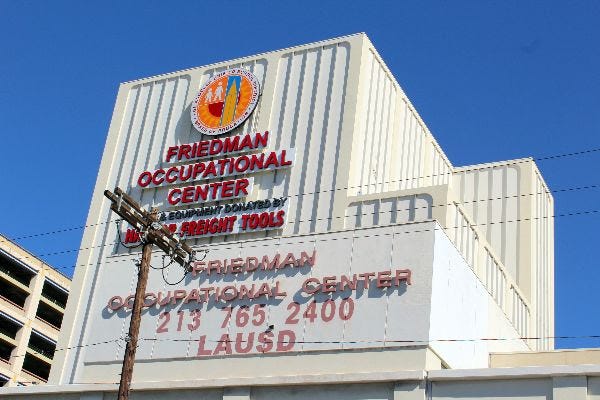
Torah on the Streets of LA
In the third Torah portion of the yearly cycle, “Lech-L’cha,” “Go Forth from your native land,” we really begin the story of our ancestors’ wandering ways. When God tells Abram to leave his father’s house “to the land that I will show you,” an epic journey begins that expands his world and wealth, and increases awareness in the world about God. “I will make of you a great nation” God says to Abram, “I will make your name great.” In those promises, and how they are brought to fruition, lies the story of a people. In Los Angeles, a city that is home to many people who have also been told, by either a voice, or from their own sense of survival, to leave their native lands, there is a place where many of them go to make their names if not great, then at least better. Named the Abram Friedman Occupational Center (after a Jewish long-time LAUSD educator and administrator) it is one of the Los Angeles Unified School District’s Division of Adult Education schools. Located on Olive Street and Venice Boulevard, you may have seen the school’s 10-story, nearly windowless tower from the 10 Freeway and wondered what it was. A hospital? A jail? With ESL classes, a high school diploma program, along with a full complement of vocational training classes, the school is the place of choice for many immigrants, and others, who, like Abram, heard a voice telling them to go forth on a journey of self-improvement.
Tying up a win with a shoestring

Edmon J. Rodman
As we are subjected to today’s media-oriented election campaigns, we can barely imagine how much money it takes to get elected. But it was not always that way, and in Los Angeles, in 1953, a young Jewish woman, just 22, Rosalind “Roz” Wiener, demonstrated how to get elected to the City Council on a bare-bones budget.
Perhaps remembered most for playing an important role in bringing the Dodgers to Los Angeles, in the week when they won the World Series, we take a look back at her first campaign for office.
Not that her campaign for the 5th district—which resulted in the first Jewish person in more than 50 years being elected to the council—didn’t include advertising or endorsements, she had both. But for the young Democrat to get elected, she found ways to cut costs, and depended on the work of a corps of young dedicated volunteers.
A determined worker, her resume included an early job in the family business. Wiener’s parents, both pharmacists, ran a drug store on the corner of Western and 4th. As a child, Rosalind helped out there, and learned how to add by working the cash register.
To begin her political career, Wiener (B. 1930), a college student majoring in public administration at USC, worked her way up through local Democratic politics, getting elected from her district to the Democratic Council Committee, and then being named to the state committee. She worked on Adlai Stevenson’s campaign for President, and Sam Yorty’s run for Congress (He originally was a Democrat.). Inspired by Congresswoman Helen Gahagan Douglas, she worked on her Senate campaign as well.
After graduating from USC, and while still living at home, Wiener applied for city council candidacy at the last minute. Without a budget for a campaign headquarters, she quickly found a solution. “The Wiener’s 7-room house was transformed into Rosalind Wiener’s campaign headquarters,” said an article in the B’nai B’rith Messenger. A large “Welcome Walk-in” sign was hung above the front door at 1341 S. Orange Dr. and she was in business.
The Wiener home was soon abuzz with a volunteer campaign staff of college students. With all the late-night snacking Mrs. Wiener posted a sign over the sink which read “The management kindly request that you wash your own cup and saucer.”
In the primary, Wiener, running against a field of eight male candidates, pulled off a surprise first place finish. In the final, running against public accountant Elmer Marshrey, she ran on a platform of “stiffer penalties for dope dealers;” the creation of a “modernized transportation” system; a “thorough overhauling” of the city charter;” and to solve juvenile delinquency, “expanded recreational facilities.”
“I pledge, that when I am on the Council, representing you,” said Wiener, “I will be on the job and you will be heard.”
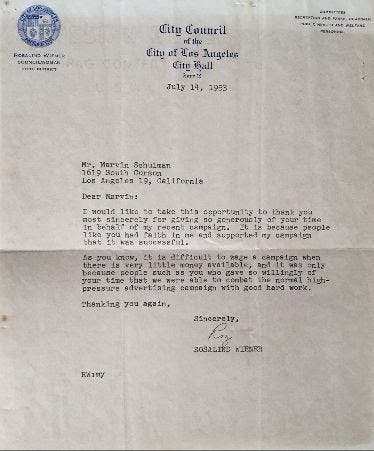
She sought supporters and received the endorsement of William H. Rosenthal, a former state assemblyman. Fighting off smears of being labeled as a “left winger,” she won with 52 percent, becoming the youngest council member ever elected and only the second woman.
“Jewish Girl Wins Councilmanic Seat,” said a headline in the B’nai B’rith Messenger, typical of that era.
After serving three terms on the city council, Wiener, who married attorney Eugene Wyman in 1954, was influential in California Democratic politics, serving as a delegate to several National conventions, and as co-chair of Dianne Feinstein’s senatorial campaigns.
On the L.A. Jewish Relations Committee, she served as vice-chair.
Soon after that first election, in a letter thanking a campaign worker, discovered and obtained by MegilLA, Wiener discussed the difficulties of the campaign, and the hurdles they had to overcome. “It is because people like you had faith in me and supported my campaign that is was successful,” said the letter. “It is difficult to wage a campaign when there is very little money available,” and “it was only because people such as you who gave so willingly of your time that we were able to combat the normal high-pressure advertising with good hard work.”
Seen on the Way/ Southeast LA
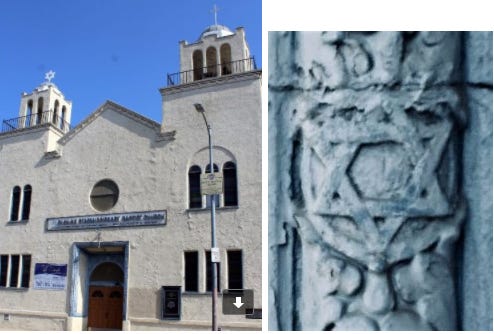
The former Tefaros Jacob, and plaster detail of entryway.
Why is that building topped both with a Star of David and a Cross? I wondered while driving south on Slauson in southeast L.A. one afternoon. The building, a block east of Slauson, on the corner of 59th St. and Brentwood, is currently the home of La Estrella Iglesia Misionera, but from 1952, according to the cornerstone, it was a Baptist Church. As the building looked to be from the 1920s, what was it before then? A check on the address in the B’nai B’rith Messenger found that in 1926 the building was home to Talmud Torah and Congregation Tefaros Jacob (also called Tefereth Ja-Acov). A conservative congregation, Tefaros Jacob, held a full complement of Shabbat and holiday services, and had a school, or Talmud Torah. Located in what was then a Jewish neighborhood, even in the 20’s, the congregation was already too large to meet in the building for the High Holy Days, and needed to rent another building on nearby Slauson. In 1952, they sold the building, moved to a new location at 4000 W. Slauson, near Windsor Hills. That building is now a church. Still unknown: Why the Star of David was not taken down when the original building changed hands. Was that part of the real estate deal? An act of thankfulness? Or just one of those L.A. quirks?



